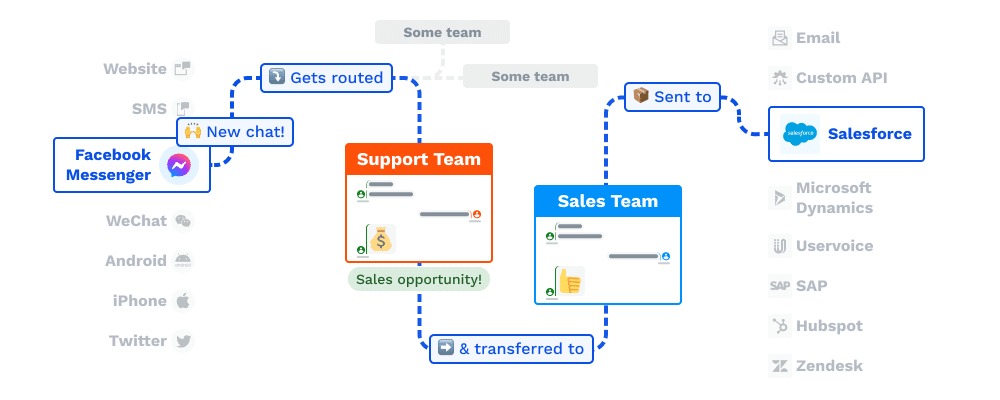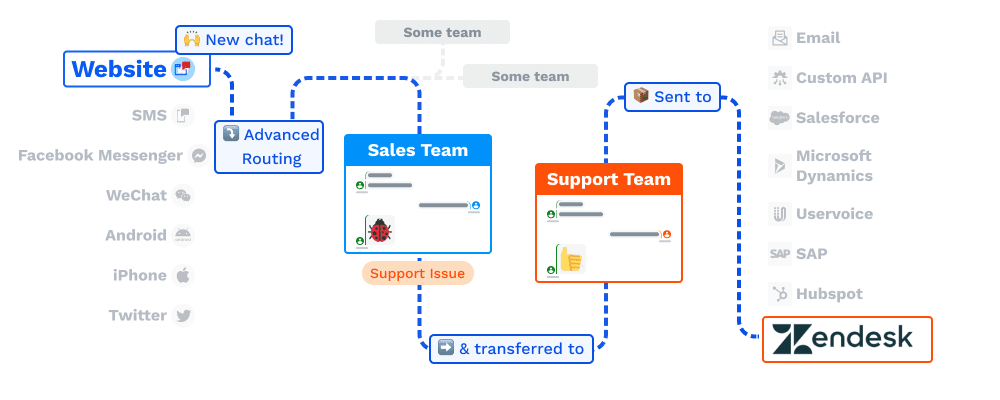
Companies spend millions of dollars annually in attempts to remove internal silos and improve communication and collaboration. But these same companies also enable and fund separate and frequently unintegrated technology stacks creating those same operational silos – it’s counterintuitive. To stay competitive, it’s imperative that companies adapt to the necessity of unified live chat.
At SnapEngage, we acutely understand that the future of B2B technology and operational efficiency is unified. We are seeing the first steps of this transition in conversational technology platforms, and particularly in live chat.
We do not envision all-in-one tech behemoths at the core of the unifying transformation. There are certain unique needs and solutions that are core requirements to functional groups’ tech stacks. Sales needs a quality CRM, Marketing requires marketing automation, and Support needs a help desk. All of these are necessities to perform daily tasks and responsibilities that each functional group holds dear to the overall company mission.
Implementing a unified customer experience creates myriad opportunities and benefits, such as:
- 84% of companies that work to improve their customer experience report a causal increase in revenue
- 93% of customers are likely to become repeat customers at businesses that deliver exceptional customer journeys
Unified live chat removes silos, improves the customer experience
Oftentimes the lack of, and need for, unification coalesces in the same areas – brand identity, project management, business intelligence, and customer experience. The ongoing tech stack arms race is resulting in completely individualized and limited functional group tech stacks. This practice is particularly detrimental for customers, prospects, and businesses in general.
Let’s take conversational technology and chat platforms as our main focus. Recent history demonstrates an unfortunate focus on a narrow, siloed view of chat platforms – essentially the opposite of a unified live chat approach. These tend to hone in on meeting an immediate need for one functional group, coupled with a general disregard for the tertiary effects that approach may have on overall customer experience and efficiency.
Let’s dive into a common example – the daunting task of communicating with a cable or internet provider. We’ve all had this experience: you chat or call into your provider, they ask you for your account information, next your reason for contacting them, and then you are transferred to the appropriate team to handle your request. Only now, you are asked for that same account information and request once again. Potentially you will follow this same routine over and over until you give up, or until you stomach it long enough to finally reach the actual parties that can assist.
What’s really going on in the aforementioned scenario is that you, the customer, are traversing a siloed experience the opposite of a unified live chat experience. This is caused by a siloed back end, information is not being passed along in the systems and teams you are traveling between. Instead each team has a completely monolithic structure, hoarding information and likely running on separated systems. Entirely because of technical issues and siloed departments, you are having an all-too-common awful experience as a customer.
Is this really the best experience available with all of these advanced technologies? Is it truly necessary being sent to entirely different departments, with different branding, and no trailing customer information? Shame on you, provider.
Focus on the customer experience first
As customer experience entails an increasingly key decision for the fastest growing demographics in the world (and not only for retention and purchasing), companies are realizing it is more important than ever to support the customer, and create the most seamless experience possible for them. Through unified communication and branding, and by removing the technology silos and their down-stream effects, a barrier-free customer experience is entirely possible.
In unified live chat, this translates to the ability for a customer or prospect to engage with a web property that has their needs and intents known – before any amount of information is shared. Then they are seamlessly routed to the right recipient from the company, the first time, to solve or address the needs at hand. This is all done behind the scenes, providing all visitors with the best possible customer experience, both fast and effective, that is available today.
Here’s what this model looks like from a technology perspective:
Visitor 1 – Support Use Case
- A Current Customer is logged into their account. They are chatting from a Google translated page in German. They’ve selected ‘help with payments’ from the chatbot menu they are presented with – in German.
- First Stop: In this scenario, the customer is brought directly to a chatbot or human agent who is knowledgeable in payments and can assist the customer with their need in German.
- Interaction Data: Because this need fell into the Support functional group, the chat transcript and accompanying activities or action items automatically flows to the help desk where it is stored for reporting and insights, in addition to any necessary actions needed (i.e. say there is a technical issue associated with this request).
- Second Stop: Let’s then say while working on resolution for this customer, the German agent identifies an opportunity and desire for the customer to upgrade their plan type. This presents a great opportunity to transfer the visitor to a different team of German speaking sales agents who can now assist the client in gaining access to a new plan that will provide the customer with more value. The transfer is made and with very limited disruption to the visitor, because their login credentials and chat transcript follows them to the next agent, they are now continuing that same dialogue with a sales agent and will soon have the new plan activated and their payment issue resolved.
- Interaction Data: Once the chat hits the sales agent and their associated CRM oriented tech stack, the new sales-oriented data is automatically pushed to the CRM for tracking and any associated action items.
Visitor 2 – Marketing/Sales Use Case
- A prospective customer is drawn to your website with interest around a webinar or piece of gated content. They are from Southeast Asia and have engaged your content before, displaying a relatively high level of intent.
- First Stop: Because this visitor has high-intent, as previously identified by your marketing automation system, instead of being served additional educational items they are directly routed to an sales development representative or automated scheduling system to further qualify the lead and begin the sales process
- Interaction Data: Once the chat hits the sales agent and their associated CRM oriented tech stack, the new sales-oriented data is automatically pushed to the CRM for tracking and any associated action items. The marketing automation data has already been captured for reporting and insights reasons.
- Second Stop: Let’s say that in this scenario, the visitor is actually already a customer who recently signed up for your service and while they came into the marketing/sales funnel as a potential prospect, they really just needed help with their configuration. This is where a transfer to the Support team comes in handy; no follow-ups, no switching systems and avoidance of the disjointed usage and branding experience that comes with that type of transition. The customer is now with your Support team getting the assistance they need and deserve.
- Interaction Data: And now the chat transcripts and any associated follow up items are being pushed to your help desk for reporting insights and any necessary action items.
These two examples represent only a couple of the many possible situations that occur daily within your currently siloed chat platform. The only way to truly address these scenarios requires an increased spend (i.e. duplicate licenses) to both functions’ desired chat platforms, or to implement a completely unified chat platform that meets the requirements for all departments, on top of the functional techstacks.
Implement a strategy that creates a unified customer experience. Deconstruct the siloed journey so all customers experience a truly remarkable, refreshing journey from start to finish. It is irrefutable that the best point of integration is at the customer experience level. The difference with a unified chat platform is that the customer experience is at the center of focus. With a unified and delightful customer journey, the business as a whole flourishes. This is why the future of chat is unified.




